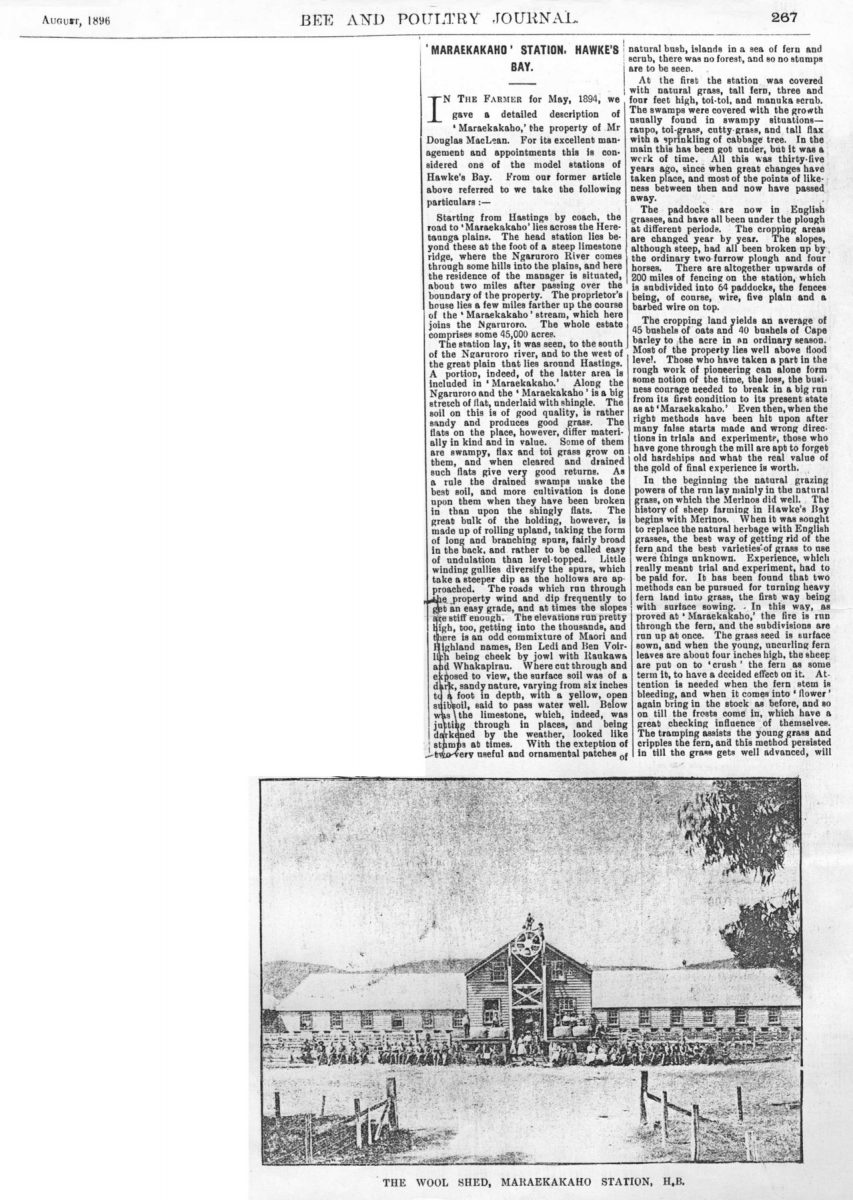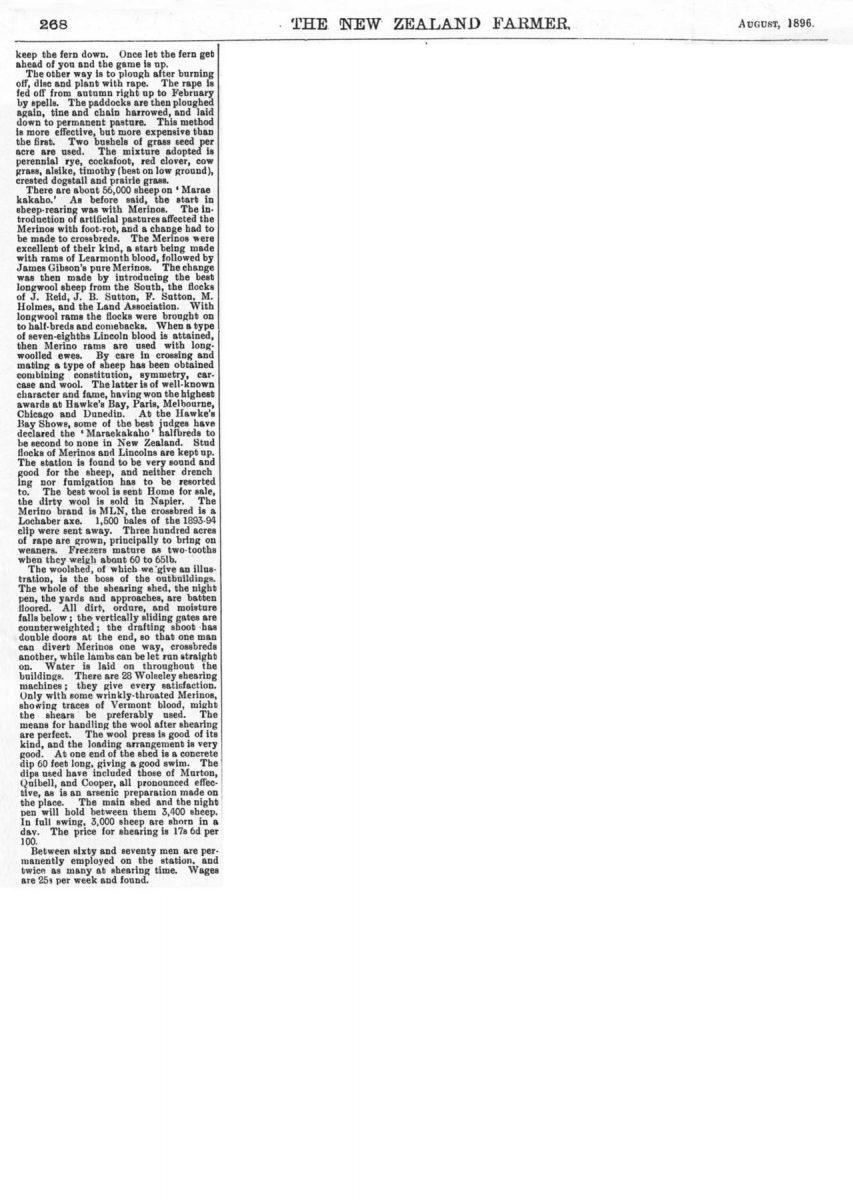AUGUST, 1896 BEE AND POULTRY JOURNAL 267
‘MARAEKAKAHO’ STATION, HAWKE’S BAY
IN THE FARMER for May, 1894, we gave a detailed description of ‘Maraekakaho,’ the property of Mr Douglas MacLean [McLean]. For its excellent management and appointments this is considered one of the model stations of Hawke’s Bay. From our former article above referred to we take the following particulars: –
Starting from Hastings by coach, the road to ‘Maraekakaho’ lies across the Heretaunga plains. The head station lies beyond these at the foot of a steep limestone ridge, where the Ngaruroro River comes through some hills into the plains, and here the residence of the manager is situated, about two miles after passing over the boundary of the property. The proprietor’s house lies a few miles farther up the course of the ‘Maraekakaho’ stream, which here joins the Ngaruroro. The whole estate comprises some 45,000 acres.
The station lay, it was seen, to the south of the Ngaruroro river, and to the west of the great plain that lies around Hastings. A portion, indeed, of the latter area is included in ‘Maraekakaho.’ Along the Ngaruroro and the ‘Maraekakaho’ is a big stretch of flat, underlaid with shingle. The soil on this is of good quality, is rather sandy and produces good grass. The flats on the place, however, differ materially in kind and in value. Some of them are swampy, flax and toi grass grow on them, and when cleared and drained such flats give very good returns. As a rule the drained swamps make the best soil, and more cultivation is done upon them when they have been broken in than upon the shingly flats. The great bulk of the holding, however, is made up of rolling upland, taking the form of long and branching spurs, fairly broad in the back, and rather to be called easy of undulation than level-topped. Little winding gullies diversify the spurs, which take a steeper dip as the hollows are approached. The roads which run through the property wind and dip frequently to get an easy grade, and at times the slopes are stiff enough. The elevations run pretty high, too, getting into the thousands, and there is an odd commixture of Maori and Highland names, Ben Ledi and Ben Voirlich being cheek by jowl with Raukawa and Whakapirau. Where cut through and exposed to view, the surface soil was of a dark, sandy nature, varying from six inches to a foot in depth, with a yellow, open subsoil, said to pass water well. Below was the limestone, which, indeed, was jutting through in places, and being darkened by the weather, looked like stumps at times. With the exteption [exception] of two very useful and ornamental patches of natural bush, islands in a sea of fern and scrub, there was no forest, and so no stumps are to be seen.
At the first the station was covered with natural grass, tall fern, three and four feet high, toi-toi, and manuka scrub. The swamps were covered with the growth usually found in swampy situations – raupo, toi-grass, cutty-grass, and tall flax with a sprinkling of cabbage tree. In the main this has been got under, but it was a work of time. All this was thirty-five years ago, since when great changes have taken place, and most of the points of likeness between then and now have passed away.
The paddocks are now in English grasses, and have all been under the plough at different periods. The cropping areas are changed year by year. The slopes, although steep, had all been broken up by the ordinary two-furrow plough and four horses. There are altogether upwards of 200 miles of fencing on the station, which is subdivided into 64 paddocks, the fences being, of course, wire, five plain and a barbed wire on top.
The cropping land yields an average of 45 bushels of oats and 40 bushels of Cape barley to the acre in an ordinary season. Most of the property lies well above flood level. Those who have taken a part in the rough work of pioneering can alone form some notion of the time, the loss, the business courage needed to break in a big run from its first condition to its present state as at ‘Maraekakaho.’ Even then, when the right methods have been hit upon after many false starts made and wrong directions in trials and experiments, those who have gone through the mill are apt to forget old hardships and what the real value of the gold of final experience is worth.
In the beginning the natural grazing powers of the run lay mainly in the natural grass, on which the Merinos did well. The history of sheep farming in Hawke’s Bay begins with Merinos. When it was sought to replace the natural herbage with English grasses, the best way of getting rid of the fern and the best varieties of grass to use were things unknown. Experience, which really meant trial and experiment, had to be paid for. It has been found that two methods can be pursued for turning heavy fern land into grass, the first way being with surface sowing. In this way, as proved at ‘Maraekakaho,’ the fire is run through the fern, and the subdivisions are run up at once. The grass seed is surface sown, and when the young, uncurling fern leaves are about four inches high, the sheep are put on to ‘crush’ the fern as some term it, to have a decided effect on it. Attention is needed when the fern stem is bleeding, and when it comes into ‘ flower ’ again bring in the stock as before, and so on till the frosts come in, which have a great checking influence of themselves. The tramping assists the young grass and cripples the fern, and this method persisted in till the grass gets well advanced, will













Do you know something about this record?
Please note we cannot verify the accuracy of any information posted by the community.